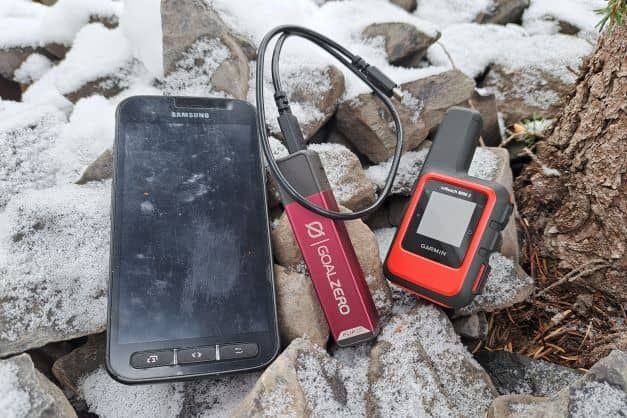Essential Winter Hiking Gear

Adventuring in winter is a magical experience, whether you are snowshoeing through beautiful forests, exploring icy canyons, or heading out for a winter overnight trip. While the winter brings beautiful landscapes and wonderful adventure, it can also have more hazards than a typical summer trip.
Let’s look at 10 key pieces of gear every winter adventurer should have!
"winter can have more hazards"
1 - Communication Device
2 - Extra Warm Layers
Bring enough clothing that you could stay warm if you had to stay in place for several hours, or even overnight depending on how remote your hike is. It’s pretty easy to stay warm when we’re moving, but think about what you would need to wait for help to come. Winter layering is an art, but luckily it’s one everyone can master!
3 - Hot Liquid
4 - Snacks, Snacks, & More Snacks
Our bodies are way better at staying warm when they are well fueled. It takes a lot of calories to keep warm, so bring more than you think you’ll need when first starting out.
Sugars and simple carbs will help you get a boost quickly; fruits, granola bars, bread, milk chocolate, and even candy. We also need healthy fats to burn longer and help us maintain our energy output, so also pack slower burning foods like nuts & butters, seeds, cheese, meats, and dark chocolate. That’s right, we mentioned chocolate twice.
5 - Hand Warmers
These aren’t just for hands! Whatever part of your body is feeling cold can benefit from a heat boost. Tuck them into your mittens, boots, or right up into your armpits if you’re deeply chilled. Hand warmers can also keep your phone battery warm and working longer!
6 - Lighter
If you do find yourself having to stay put and wait for help, a fire can be a game changer. Starting a fire outside of established fire pits is forbidden in most provincial and national parks. However, in the event of a true emergency it’s actually ok (especially in winter where the chance of accidentally starting a forest fire are much lower).
Pro-tip: hand sanitizer is flammable, so it can be used as a firestarter; just pour some on small dry twigs, and you’ll have a fire in no time.
7- Repair Kit
Being able to repair your gear in the field can turn a potential catastrophe to an inconvenience. Snowshoeing with a repaired snowshoe is a lot more fun than wading through thigh deep snow! You’ll want to tailor your repair kit to your activity. Here are some ideas for what you might include in your own kit:
Snowshoeing | Spare ski strap, spare pole basket |
Icy Hikes | Zip ties to repair traction aids |
Overnight Trips | Spare hip belt buckle for heavy packs, tent pole repair kit, stove repair kit, sleeping pad repair kit |
All Activities | Tape, cord, ski strap, and knife |

8 - Headlamp
It gets dark early in winter! Even if you aren’t planning on hiking after sunset, delays happen! Learning how to figure out how long a hike will take is a great idea, but even the best navigators get caught out sometimes. A headlamp will make finding your way back to the car so much easier than stumbling around in the dark or draining your phone battery using the flashlight function.
9 - Emergency Blanket or Tarp
These are incredibly lightweight, but they are versatile and useful. They will keep you dry, and are remarkably good at keeping you warm as well. They can also make a shelter.
10 - Trip Plan
Finally, the most important emergency item you should always have on every adventure doesn’t even weigh anything at all. What could this magic item be? A trip plan left with a responsible friend, of course! No matter how short the trip or how experienced the adventurer’s are, it’s always a good idea to let someone know where you are going, and when you plan to be back. That way, if you do end up in trouble, searchers will start looking for you much sooner, and they’ll know where to look. BC Adventuresmart has a great trip plan app that makes building and sharing your trip plan super easy!
Ok, ok, ok, we said 10 items, but there are two more items that can really come in handy. Counting may not be our strong suit, but preparing for winter adventures is!
11- A Shovel
12 - A Thermarest
Other Posts of Interest
Related Courses
Fresh off the Press
Most Popular Stories
Tags
You Might Also Like...
Spread the Love - Share this article on your socials...

























